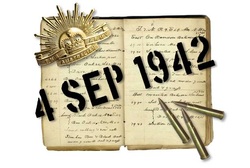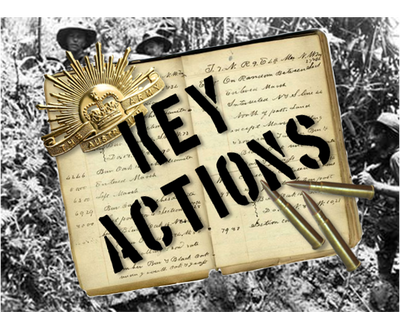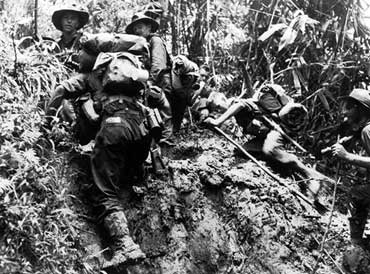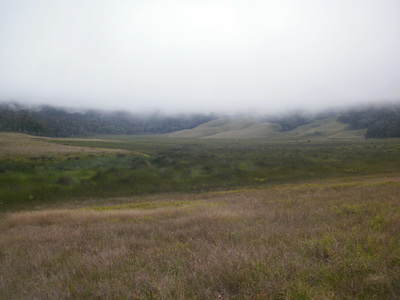
Myola is an area in deep jungle not far from Mount Bellamy and in the heart of the Owen Stanley Ranges. It is a few kilometres east of the main Kokoda Track. There are two dry lake beds both are open expanses of ground inside miles and miles of jungle.
At the start of the campaign, when looking for a for a dropping ground for supplies, Lieutenant Herbert Kienzle a logistician from the Australian New Guinea Administration Unit (ANGAU) set out to explore this area. In early August Kienzle reached the first dry lake, which was covered with kunai grass. It made a suitable dropping zone and he soon turned the area into an extensive supply depot. He named the area Myola (after the wife of his commanding officer). Nearby, and at a higher altitude, was a second dry lake, which became known as Myola 2 and it was also used as a drop zone and supply depot; however:
At about 11am on the 2nd September the Japanese pursuing the Australians were seen moving towards a standing patrol that was at the rear of the defences in the vicinity of Templeton’s Crossing. The standing patrol shot ten of the Japanese; however, it wasn’t long before the main positions were in contact and the Japanese were moving round the left flank. Lieutenant Colonel Caro (Commanding Office 2/16 Battalion) decided that it was time to move on as he feared the enemy would soon outflank his force.
The 2/16th Battalion struggled over the rough country through Templeton's Crossing and continued on to Myola .They arrived in the defended locality at Templeton’s that the 2/14th occupied and the 2/16th moved out 2/14th moved out to heading for Myola. The 2/14th arrived at Myola on the 4th September, the 2/16th on the 5th.
At Myola they received a hot meal. They washed and were given clean clothes to replace the rotten ones they were wearing. They exposed their feet to the sun, for some their socks had to be cut away. Whilst this short period of recuperation was undertaken Myola was being dismantled, stores and ammunition were being destroyed or removed rearwards as fast as possible. It was very obvious to the soldiers their rest was to be short lived and they were to be on the move again very soon.
It was not long before they were all crawling, sliding and edging their way through mud in torrential rain towards Kagi and Efogi. They began to arrive in the early afternoon of the 5th September. In leaving Myola, the Australians were relinquishing there main supply point at a time when the supplies which had meant so much to them were now coming from the air with some regularity.
At the start of the campaign, when looking for a for a dropping ground for supplies, Lieutenant Herbert Kienzle a logistician from the Australian New Guinea Administration Unit (ANGAU) set out to explore this area. In early August Kienzle reached the first dry lake, which was covered with kunai grass. It made a suitable dropping zone and he soon turned the area into an extensive supply depot. He named the area Myola (after the wife of his commanding officer). Nearby, and at a higher altitude, was a second dry lake, which became known as Myola 2 and it was also used as a drop zone and supply depot; however:
At about 11am on the 2nd September the Japanese pursuing the Australians were seen moving towards a standing patrol that was at the rear of the defences in the vicinity of Templeton’s Crossing. The standing patrol shot ten of the Japanese; however, it wasn’t long before the main positions were in contact and the Japanese were moving round the left flank. Lieutenant Colonel Caro (Commanding Office 2/16 Battalion) decided that it was time to move on as he feared the enemy would soon outflank his force.
The 2/16th Battalion struggled over the rough country through Templeton's Crossing and continued on to Myola .They arrived in the defended locality at Templeton’s that the 2/14th occupied and the 2/16th moved out 2/14th moved out to heading for Myola. The 2/14th arrived at Myola on the 4th September, the 2/16th on the 5th.
At Myola they received a hot meal. They washed and were given clean clothes to replace the rotten ones they were wearing. They exposed their feet to the sun, for some their socks had to be cut away. Whilst this short period of recuperation was undertaken Myola was being dismantled, stores and ammunition were being destroyed or removed rearwards as fast as possible. It was very obvious to the soldiers their rest was to be short lived and they were to be on the move again very soon.
It was not long before they were all crawling, sliding and edging their way through mud in torrential rain towards Kagi and Efogi. They began to arrive in the early afternoon of the 5th September. In leaving Myola, the Australians were relinquishing there main supply point at a time when the supplies which had meant so much to them were now coming from the air with some regularity.


